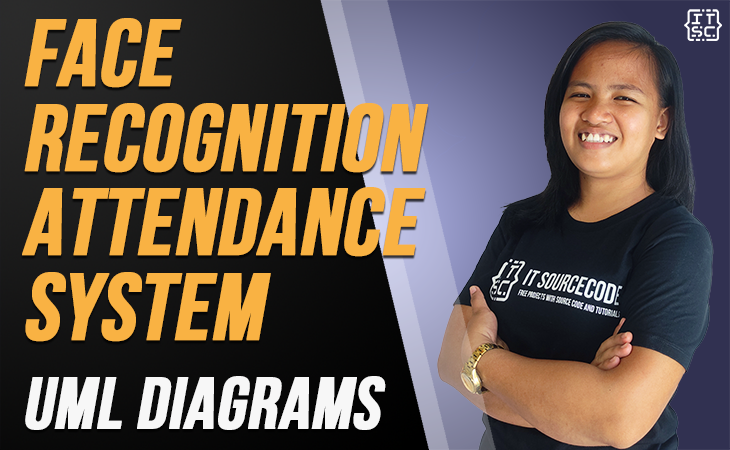UML Diagrams for Face Recognition Attendance System
The UML Diagrams for Face Recognition Attendance System are based on Unified Modeling Language which was used to represent the system’s primary users, roles, activities, artifacts, or classes. The UML Diagrams are created to easily understand, update, maintain, and document the methodologies and development of the face recognition attendance system.
The UML diagrams for face recognition attendance system were used to visualize the project. It can be done before the development begins or to document its progress once it is completed. However, these UML Diagrams can be used in any sector, not only in software engineering. Its overall objective is to help teams or developers visualize what a project is or how it will work.
Face Recognition Attendance System UML Diagrams: Details
The table shows the name and details of the face recognition system UML diagrams. It has complete information on project components and diagraming tools.
| Name: | Face Recognition Attendance System UML Diagrams |
| Abstract: | Face Recognition Attendance System UML Diagrams are used to represent the face recognition process as well as its primary users, roles, activities, artifacts, or classes. |
| Users: | School Admin, Personnel, and Students. It can also be used by private establishments and companies. |
| Tools Used: | Diagram tools that provide UML diagram symbols. |
| Designer: | ITSourceCode.com |
List of UML Diagrams for Face Recognition Attendance :
- Sequence Diagram
- Activity Diagram
- Class Diagram
- Use Case Diagram
- Deployment Diagram
- Component Diagram
The UML Diagrams of Face Recognition Attendance System
Here are the UML Diagrams that complete the Face Recognition Attendance System. Each of the UML Diagrams has a major role in achieving a well-developed and functioning Face Recognition System.
Sequence Diagram for Face Recognition Attendance System
The Sequence Diagram for Face Recognition Attendance System represents the scenario and the messages that must be passed between objects. This is done for the scenario’s functionality to be realized. It’s an interaction diagram that shows how activities are carried out, including when and how messages are sent.

The face recognition attendance system sequence diagram has several boxes (objects) which are the face recognition (device), the system records, the attendance information, and the visitor’s records. Its user could be the employer and employees (establishments) and students (schools), and the messages have a flow showing the alternative in every decision.
The explanation for the face recognition attendance system discusses how the illustration works. It has the figures which will clarify the sequence of activities and their alternatives. The box figures represent the object, the stick man is for the user, and the broken lines are for the lifelines. Messages are then presented by vertical arrows.
Activity diagram for Face Recognition System
The Face Recognition System Activity Diagram represents the behavior of the project in terms of its activities. It contains the important details on the activities and constraints done in the project. It is one of the methods used for project development. It represents the system’s major activities and constraints that lead to paths that the project includes. They were labeled properly to guide programmers and users.
Activity Diagram for Face Recognition System (Admin, Staff, and Students) – This illustration shows the activities and scenarios done when the admin registers new information. The actions and decisions included were all emphasized here.
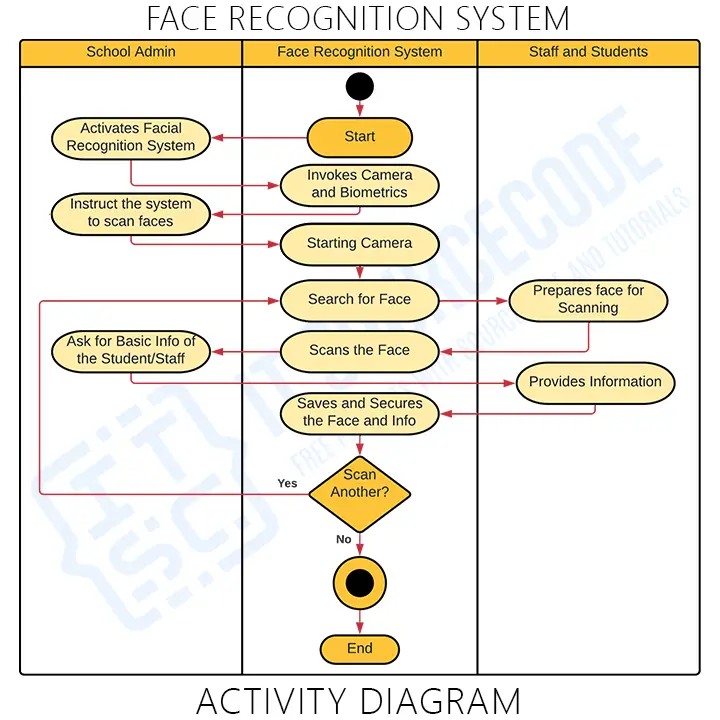
The diagram shows the series of activities and decisions when saving new information from the students and staff. The admin will activate the face recognition to register new faces and save them into the database. This is to keep the basic information needed for various activities and future use.
This diagram can also be applied to other establishments. The activities included were also applicable for other scenarios and can be modified to meet the other requirements. You can download this diagram and use it for your project.
Face Recognition System Activity Diagram (for Students, Staff, and Visitors). This diagram now shows the series of scenarios while using the face recognition system. It illustrates the activities or events done when the system is in use. The system design can show you the functions once it is operated.

The designed diagram portrays the scenario when a student, visitor, or staff enters the school. The camera will scan their faces and validate if they exist in the database.
As soon as the face is determined, the system will confirm if the face is either a student or staff. If the face is none of the two, the system will automatically conclude that the person is a visitor. Then the system will require the visitor’s information and the purpose of the transaction.
Additionally, the activity diagram depicts software operations as a series of actions. These diagrams are used to document and define the system processes and use cases. It can clarify difficult use cases to simplify and improve any process. An activity diagram also models the system’s actions, functions, and processes.
Class Diagram for Face Recognition Attendance System
The Class Diagram for Face Recognition Attendance System is a designed diagram that shows the system’s classes (data) and their relationships. This diagram is similar to a flowchart in which classes are represented by boxes with three rows inside. The top rectangle holds the class’s name; the middle rectangle contains the class’s properties, and the bottom row contains the class’s operation (methods).

Class diagrams reveal the class structure blueprint of the Face Recognition Attendance System. It is used to model the items that make up the system and depict their relationships. This is to define the function of an object and the operation it provides within the system.
Use Case Diagram for Face Recognition Attendance System
The Use Case Diagram is a structural illustration of Face Recognition Attendance System’s processes that helps programmers in its development. Use Case Diagram shows the processes included in Face Recognition Attendance System as well as its users. It serves as the blueprint or core of the said system that will be the basis for building it.
The use-case diagram in UML represents the behavior of the face recognition system and aids in capturing its requirements. It describes a system’s high-level functions and scope. The interactions between the system and its actors are also depicted in these diagrams.
Face Recognition Attendance System General Use Case Diagram – This diagram shows the general processes or functions that the system could do and is based on the transactions needed in doing or conducting an Attendance checking using Face Recognition.
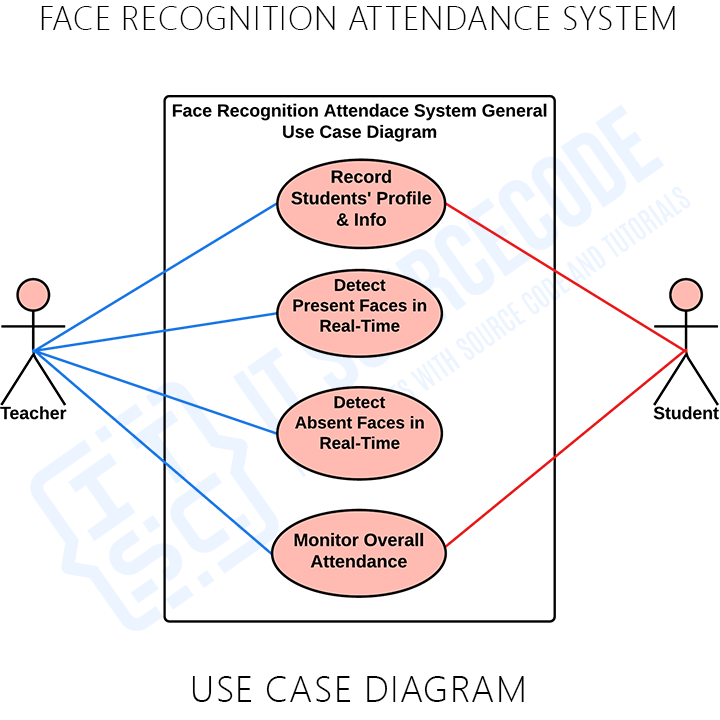
Face Recognition Attendance System Specified Use Case Diagram – this illustration has a more detailed figure of use case diagram using include and Extend. This is to help you specify the included activities in completing a process or task. That will also help users determine the right way of managing the Face Recognition Attendance System.
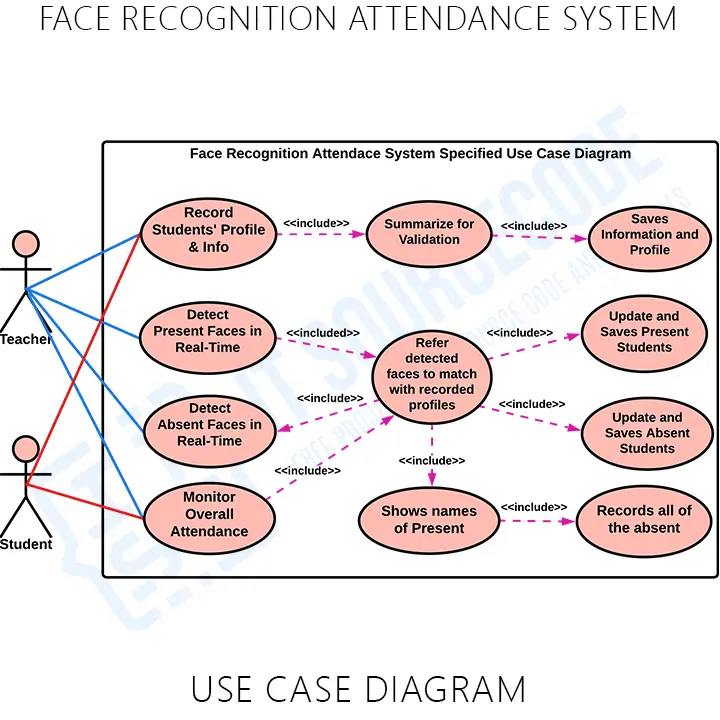
The role of this Use case Diagram using the include and Extend label is to inform your readers and users that some tasks and processes may be completed without invoking all the subtasks. They were only used when they were called or needed.
The broken arrows are indications that the following diagrams connected to them are parts of a process. They could either be one of the indications which were the include or extend. The “include” indication means that the following use case should be performed to finish the task and the “extend” indication is otherwise.
Component Diagram of Face Recognition Attendance System
The component diagram for face recognition system is an illustration of how the system components work together to make the system operate correctly. It shows how the software’s parts are organized and how they depend on each other. This diagram also gives a high-level look at the parts of a system.
This component diagram of the face recognition system illustrates the components of every hardware and software node. The component diagram below is a detailed illustration of the Deployment Diagram for Face Recognition System.
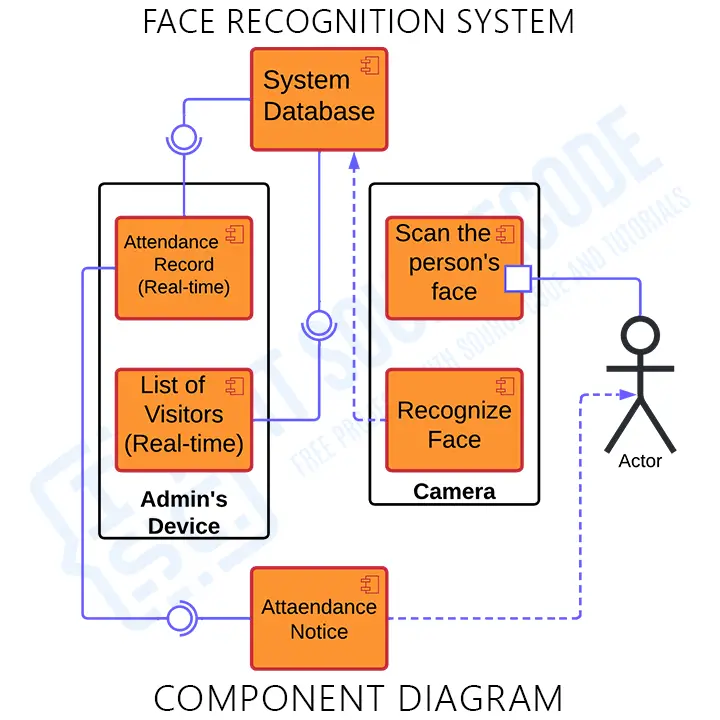
The Face Recognition System UML component diagram explains the sketch of the required software and hardware components and the dependencies between them. These components are labeled to clarify their part in the system’s operation. They were represented by symbols that explain their function and role in the overall face recognition system operation.
The component diagram of face recognition system has 8 components which are facial scanning, recognition, system database, attendance recording, visitor’s recording, and attendance notice for the scanned person if he/she is recognized by the system. The visitor’s information will be gathered by the system from confirmation of activities inside the establishment.
UML Diagrams for Face Recognition Attendance System (PDF)
The UML diagrams for Face Recognition Attendance PDF are compiled and provided here and can be accessed for free. It has the complete discussion of the UML Diagrams and you can easily download these by clicking the button below.
This PDF File for Face Recognition Attendance UML Diagrams can be modified if needed. Its diagrams were based on software engineering ideas. This means that the UML diagrams could also be applied to your Capstone Project.
How does a Face Recognition Attendance System work?
Facial recognition is software that thoroughly maps a person’s facial attributes and stores them in the database to be used as a reference whenever they need the recognition. To validate an individual’s identification, the software compares a live capture or digital image to a piece of saved facial information using deep learning techniques.
The method of recognizing or verifying a person’s facial features is known as facial recognition. It uses a person’s facial characteristics to capture, analyze, and compare patterns. Face detection is required to detect and locate human faces in photos and videos. This detection has several advantages, including improved security, ease of integration, and automatic identification.
Facial recognition systems are used to track or identify people with criminal records who are wanted. When a database matches a person’s face, the developed algorithms make it easy to track down criminals. If the technology detects a facial match, the authorized personnel were notified.
Importance of UML Diagrams for Face Recognition Attendance System
The importance of the Face Recognition Attendance System UML Diagrams is that it offers standard notation that any object-oriented method can use. This is also used to choose and combine the best aspects of preceding notations.
The basic goal of the Face Recognition Attendance UML Diagram is to provide a general-purpose, easy-to-understand modeling language that applies to all. UML is not a development approach, but it is used in conjunction with other methods to create a successful face recognition attendance system.
What are UML Diagrams for Face Recognition Attendance System?
The Diagrams for Face Recognition Attendance System are based on Unified Modeling Language which is the standard language for describing, visualizing, building, and documenting software system artifacts. These are also used in business modeling and non-software systems. It has been discovered that all UML diagrams serve an important role in the Face Recognition System development.
The Unified Modeling Language (UML) is a platform-independent and progressive modeling language used in the software engineering field to depict a system’s architecture. UML Diagrams are the visual representation of the project’s architecture, development, and implementation.
Conclusion:
All in all, the Face Recognition Attendance UML Diagrams work together to achieve their most desired functions. All of these were designed to guide programmers and beginners of what should be the behavior and structure of the Face Recognition Attendance System.
By completing all the UML Diagrams, project development would be much easier and attainable. These UML diagrams were given to teach you and guide you through your project development journey. You can use all f the given UML diagrams as your reference or have them for your project development. The ideas presented in UML Diagrams were all based on Face Recognition requirements.
Related Articles:
- University Management System UML Diagrams
- E-Commerce Website UML Diagrams
- Point of Sale (POS) System UML Diagrams
- Payroll Management System UML Diagrams
- Online Car Rental System UML Diagrams
Recommended Articles from the Author:
- Attendance Management System Project Report
- Employee Attendance Management System Project Report
- Blood Bank Management System Project Report
- Bank Management System Project Report and Documentation
- Project Report on Pharmacy Management System
Inquiries:
Now let me ask you something. What have you learned through the discussion? May this article help you with your projects in the future! If you have inquiries or suggestions about the Face Recognition Attendance System UML Diagrams just leave us your comments below.
Keep us updated and Good day!

